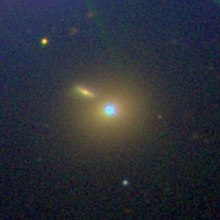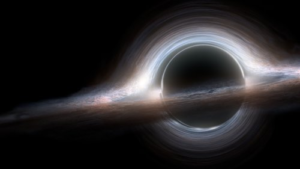In News: Astronomers from Switzerland and Germany have performed multiwavelength observations of a high-synchrotron-peaked blazar known as Mrk 421
What’s a Blazar?
- A blazar is a feeding super massive black-hole (SMBH) in the heart of a distant galaxy that produces a high-energy jet viewed face-on from Earth.
- Like other forms of active galactic nuclei (AGN), blazars are the most luminous and energetic objects in the known universe.
- The central SMBH that drives an AGN are the nucleation seeds that stimulate the formation of their host galaxies, while the SMBH itself grows in the process.
- This symbiotic relationship is an analogy for BLAZAR VENTURE’s role in nurturing new businesses that have the potential to transform their industries, create new ecosystems for their customers, and in so doing create a new galaxy of value for their investors, founders, employees, and customers.
Structure of Blazars
- Blazars, like all active galactic nuclei (AGN), are thought to be ultimately powered by material falling onto a supermassive black hole at the center of the host galaxy.
- Gas, dust and the occasional star are captured and spiral into this central black hole, creating a hot accretion disk which generates enormous amounts of energy in the form of photons, electrons, positrons and other elementary particles. This region is relatively small, approximately 10−3 parsecs in size.
- There is also a larger opaque toroid extending several parsecs from the black hole, containing a hot gas with embedded regions of higher density. These “clouds” can absorb and re-emit energy from regions closer to the black hole. On Earth, the clouds are detected as emission lines in the blazar spectrum.
- Perpendicular to the accretion disk, a pair of relativistic jets carries highly energetic plasma away from the AGN. The jet is collimated by a combination of intense magnetic fields and powerful winds from the accretion disk and toroid. Inside the jet, high energy photons and particles interact with each other and the strong magnetic field. These relativistic jets can extend as far as many tens of kiloparsecs from the central black hole.
- All of these regions can produce a variety of observed energy, mostly in the form of a nonthermal spectrum ranging from very low-frequency radio to extremely energetic gamma rays, with a high polarization (typically a few percent) at some frequencies.
- The nonthermal spectrum consists of synchrotron radiation in the radio to X-ray range, and inverse Compton emission in the X-ray to gamma-ray region.
- A thermal spectrum peaking in the ultraviolet region and faint optical emission lines are also present in OVV quasars, but faint or non-existent in BL Lac objects.

What’s A Super Massive Black Hole (Smbh)?

- In the heart of every galaxy is an SMBH, a concentration of matter so dense that not even light can escape, in the center of which our current theories of spacetime break down.
- They range from hundreds of thousands to billions of solar-masses, concentrated into an object the size of our solar system.
- They are the nucleation seeds that attract primordial gas to form new galaxies of hundreds of billions of stars and their planets, whose combined mass, along with dark matter, forms a gravitationally bound structure that so that in all but the most violent cases, average stars can live out their multi-billion year lifetimes in relative peace.
















